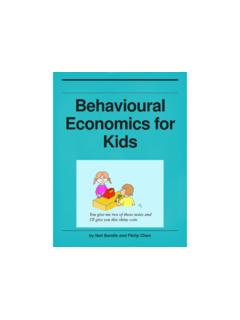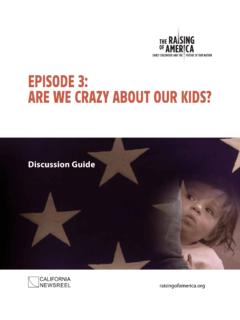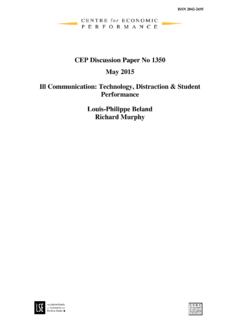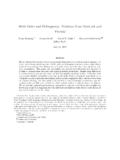Transcription of CLASSICAL AND EYNESIAN ECONOMIC …
1 CL A S S I C A L A N D KE Y N E S I A N EC O N O M I C EX P L A N AT I O N S F O R UN E M P L O Y M E N T Michael Griffiths 5/12/2007 Prof. Roy Rotheim EC103: Introduction to Macroeconomics CLASSICAL and Keynesian ECONOMIC Explanations for Unemployment Michael Griffiths Economics | Prof. Roy Rotheim Skidmore College 2 Introduction Unemployment is a key measure of ECONOMIC health. It is a major factor in determining how healthy an economy is; if the economy maximized efficiency, everyone would be employed at some wage. An individual unemployed is both unproductive and a drain on society s resources. However, while unemployment seems a basic statistic the number without jobs divided by those with jobs the issue is anything but. Unemployment is a powerful statistic that shapes government policy and personal decisions. The government keeps a close eye on the unemployment rate.
2 Not only does unemployment indicate that the economy isn t operating at peak efficiency, but politicians have noticed that high unemployment correlates with losing elections. The Federal Reserve believes that unemployment below a certain threshold they refer to as the natural rate of unemployment leads to inflation, reflecting an observation by the economist A. W. Philips correlating unemployment to inflation during the 1960s. The Bureau of Labor Statistics is the US agency that monitors and reports on unemployment and other labor statistics. In 2006, the average unemployment rate was This number only includes a subset of the total US population: the currently unemployed people who are willing and able to work. This subset of the population excludes children and infants, people in the prison system, and people who choose, for various reasons, not to work.
3 Choosing to measure unemployment this way assumes that a CLASSICAL free 1 Bureau of Labor Statistics market perspective works. That is, people making free choices will inevitably lead to the best outcome; everyone who wants a job will receive a job. In that sense, it is pointless to measure people who are unable or unwilling to work: if they wanted a job, they could get a job, and they evidently have a good reason not to work. This perspective envisions unemployment simply as the time spent between jobs; assuming people keep looking for a job, they will find one. John Maynard Keynes criticized this viewpoint as misleading. He pointed out that the people who drove demand for goods and services are the same people participating in the labor market. Unemployment means less income, which in turn means less demand; less demand causes the demand curve in the labor market to change, creating a feedback cycle.
4 This paper will examine unemployment from both the CLASSICAL and Keynesian perspective. CLASSICAL Model of Unemployment Under the CLASSICAL perspective, ..unemployment is seen as a sign that smooth labor market functioning is being obstructed in some way. The CLASSICAL approach assumes that markets behave as described by the idealized supply-and-demand (Goodwin 12) This paper will present a basic model of a labor market under the CLASSICAL perspective. This model will treat both labor supply and demand independently, and assumes that the market exists in CLASSICAL and Keynesian ECONOMIC Explanations for Unemployment Michael Griffiths Economics | Prof. Roy Rotheim Skidmore College 3 isolation. While the labor market may experience external shocks, the labor market does not depend on exterior circumstances. This paper will then use the presented model to explain how unemployment works under a CLASSICAL perspective.
5 CLASSICAL Labor Demand The demand for labor in the entire economy is simply the aggregate demand for labor from each company. It follows that the behavior of the demand curve is the aggregate behavior of every company in the economy. In this light, it is easier and simpler to analyze unemployment from the standpoint of an individual company and extrapolate that behavior to the entire economy. We can safely assume that the ultimate goal of any company is to maximize profit. It is a small leap from there to assume that as long as employing additional labor will increase profit, the company will employ additional labor; and that the inverse is true. Profit is defined as a firm s revenues minus its expenses. In this simplistic model, we will assume that the only expenses a company incurs are the cost of capital and the wages paid to employees. While the firm will incur other expenses such as legal fees, marketing, pensions, and general operating overhead, the model does not need to consider these factors to explain the relationship between firm profit and labor demand.
6 Therefore, if we have a company such as General Motors, its profit will be a function of how many cars it can sell and at what price, minus its expenses, which are the number of workers employed at some wage and the cost of the capital. Furthermore, we will assume that this example occurs in the short term and thus revenue per product sold, wage per worker, and cost per unit of capital are all constant. Thus, we can express this as a function ),,(minPthat describes profit: (1)kmwirnminP),,( Refer to the following table for an explanation of the symbols chosen: VA R I A B L E S CO N S T A N T S P(n,i,m) = function describing profit r = revenue per product sold n = amount produced = function n(i) dependent on i. w = wage per worker i = number of workers k = cost per unit of capital m = number of units of capital Profit will be maximized at an inflection point for the function ),,(minP.
7 In other words, the rate of change of function ),,(minP with respect to i will be zero. This is the partial derivative of the function: (2)wdidnrdimindP),,( CLASSICAL and Keynesian ECONOMIC Explanations for Unemployment Michael Griffiths Economics | Prof. Roy Rotheim Skidmore College 4 The specifics of this function will vary for each company. However, we can make some deductions. The expression didnis referred to as the marginal product of labor, because it represents the change in output for each change in the number of workers. In the short term, the marginal product of labor will decrease after a certain point. For example, General Motors cannot hire any workers beyond a certain point, regardless of how much they are paid. Each factory only has a finite number of spots on each assembly line, and attempting to pack more workers onto the line is sure to result in both missing limbs and lawsuits, but also a loss of productivity with people incessantly getting in the way.
8 From that perspective, the point at which wdidnr will be where profit is maximized. From then on, profit will diminish with each additional employee. The following graph illustrates the impact of the marginal product of labor on profit, with L1 the point at which wdidnr: LaborProfitL1P1 The function wdidnr explains how the aggregate demand curve for the economy is expressed. As wage decreases, the point at which wdidnr will move to the right on the graph; the company can hire additional workers without reducing profitability. Thus, demand for labor increases within each company as wages drop, and so demand for labor increases in the overall economy as wages drop. A stylized demand for labor graph is below: CLASSICAL and Keynesian ECONOMIC Explanations for Unemployment Michael Griffiths Economics | Prof. Roy Rotheim Skidmore College 5 L1L2L3W3W2W1 Demand for LaborLaborWage This stylized graph assumes that wdidnr is a linear function.
9 However, it is entirely possible that marginal utility is not linear. For example, most manufacturing companies do not allow the public into the production area. Quite ignoring sabotage and safety, this is because people milling around in an assembly line would slow down the process. Keeping people out of the way has a value of more than zero, as the existence of security firms that protect corporate property indicate. At some point, even if a worker was not paid, an additional individual within the factory would reduce the overall productivity of the factors. CLASSICAL Labor Supply People are not companies and do not maximize profit. Nonetheless, people still maximize something: they choose personal time over work time. Whether they are cleaning the house, taking their kids to soccer practice, or watching the latest episode of 24, people do more than work, eat, and sleep.
10 People also place some sort of value on their non-work time; otherwise, people would universally work as much as they possibly could. Instead, the amount individuals choose to work varies. The variation in how much people choose to work suggests that people are maximizing something other than money. Economics typically uses the philosophical notion of utility, initially invented to promote an ethical paradigm. Utility is largely synonymous with happiness, which makes sense: people try to maximize their happiness. Dissecting utility can be complicated for instance, determining short-term utility vs. long-term utility and is a problem often left to psychologists and politicians, with mixed results. The function describing utility would be different for every individual, and cannot be easily expressed mathematically. Still, we can assume the relationship between the amount of work and the amount of non-work time is a basic indifference curve: the more of something people have, the less they value more of it.






